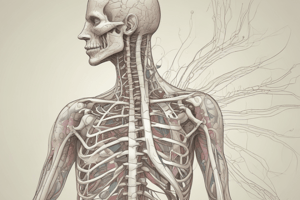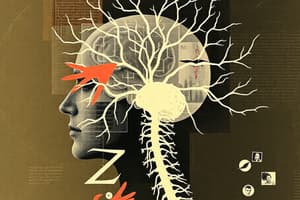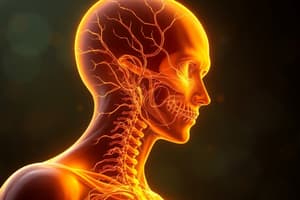Podcast
Questions and Answers
What is the primary function of myotomes in the nervous system?
What is the primary function of myotomes in the nervous system?
- To connect cranial nerves to the brain
- To provide sensory input from the skin
- To innervate muscles or muscle groups (correct)
- To transmit signals between spinal nerves
Which of the following statements about cranial nerves is FALSE?
Which of the following statements about cranial nerves is FALSE?
- Cranial nerves are only motor in function (correct)
- They arise from the undersurface of the brain and brainstem
- They can be sensory, motor, or mixed
- There are 12 pairs of cranial nerves
Which cranial nerve is primarily associated with the ophthalmic division of the trigeminal nerve?
Which cranial nerve is primarily associated with the ophthalmic division of the trigeminal nerve?
- Facial Nerve
- Trigeminal Nerve (correct)
- Hypoglossal Nerve
- Optic Nerve
What method is used to identify cranial nerves?
What method is used to identify cranial nerves?
Shingles, also known as Herpes Zoster, affects which part of the nervous system?
Shingles, also known as Herpes Zoster, affects which part of the nervous system?
How many pairs of cranial nerves emerge from the brain?
How many pairs of cranial nerves emerge from the brain?
Which part of the spinal nerve is responsible for sensory input?
Which part of the spinal nerve is responsible for sensory input?
What is the primary function of the ventral ramus?
What is the primary function of the ventral ramus?
What is the main characteristic of mixed nerves?
What is the main characteristic of mixed nerves?
How many cervical nerve pairs are there?
How many cervical nerve pairs are there?
What do nerve plexuses primarily allow for?
What do nerve plexuses primarily allow for?
Where do the lumbar, sacral, and coccygeal nerve pairs descend from?
Where do the lumbar, sacral, and coccygeal nerve pairs descend from?
Which spinal nerves are described as having no plexuses and run in segments directly to their body regions?
Which spinal nerves are described as having no plexuses and run in segments directly to their body regions?
What is the primary function of the Cervical Plexus?
What is the primary function of the Cervical Plexus?
Which plexus is primarily responsible for innervating the thigh and leg?
Which plexus is primarily responsible for innervating the thigh and leg?
What nerves are included in the Brachial Plexus?
What nerves are included in the Brachial Plexus?
Which statement about the Sacral Plexus is correct?
Which statement about the Sacral Plexus is correct?
What is the role of the phrenic nerve?
What is the role of the phrenic nerve?
What region does the Lumbar Plexus primarily innervate?
What region does the Lumbar Plexus primarily innervate?
What can dermatomes illustrate?
What can dermatomes illustrate?
Where is the Brachial Plexus located?
Where is the Brachial Plexus located?
Which of the following structures is part of the Sacral Plexus?
Which of the following structures is part of the Sacral Plexus?
What vertebral levels correspond to the Cervical Plexus?
What vertebral levels correspond to the Cervical Plexus?
What is the primary function of the Olfactory Nerve (CN I)?
What is the primary function of the Olfactory Nerve (CN I)?
Which muscles are innervated by the Oculomotor Nerve (CN III)?
Which muscles are innervated by the Oculomotor Nerve (CN III)?
Which function is associated with the Vestibulocochlear Nerve (CN VIII)?
Which function is associated with the Vestibulocochlear Nerve (CN VIII)?
What condition is typically caused by injury to CN VII (Facial Nerve)?
What condition is typically caused by injury to CN VII (Facial Nerve)?
What does the Glossopharyngeal Nerve (CN IX) primarily innervate?
What does the Glossopharyngeal Nerve (CN IX) primarily innervate?
How does the Vagus Nerve (CN X) affect the body's organs?
How does the Vagus Nerve (CN X) affect the body's organs?
What type of nerve is the Trigeminal Nerve (CN V)?
What type of nerve is the Trigeminal Nerve (CN V)?
Which cranial nerve primarily helps in the swallowing process?
Which cranial nerve primarily helps in the swallowing process?
Which cranial nerve is uniquely formed by a union of cranial and spinal roots?
Which cranial nerve is uniquely formed by a union of cranial and spinal roots?
What is the main function of the Hypoglossal Nerve (CN XII)?
What is the main function of the Hypoglossal Nerve (CN XII)?
Which cranial nerve is responsible for detecting facial sensations?
Which cranial nerve is responsible for detecting facial sensations?
What is a common result of injury to the Abducens Nerve (CN VI)?
What is a common result of injury to the Abducens Nerve (CN VI)?
Which cranial nerve is directly involved in facial expression?
Which cranial nerve is directly involved in facial expression?
Flashcards
Cervical Plexus
Cervical Plexus
A network of nerves located in the neck that innervates the skin and muscles of the neck, upper shoulders, and parts of the head.
Brachial Plexus
Brachial Plexus
A network of nerves located in the shoulder region that innervates the lower part of the shoulder and the entire arm.
Lumbar Plexus
Lumbar Plexus
A network of nerves located in the lumbar region (lower back) of the spine that innervates the thigh and leg.
Sacral Plexus
Sacral Plexus
Signup and view all the flashcards
Phrenic Nerve
Phrenic Nerve
Signup and view all the flashcards
Referred Pain
Referred Pain
Signup and view all the flashcards
Dermatomes
Dermatomes
Signup and view all the flashcards
Radial Nerve
Radial Nerve
Signup and view all the flashcards
Musculocutaneous Nerve
Musculocutaneous Nerve
Signup and view all the flashcards
Ulnar Nerve
Ulnar Nerve
Signup and view all the flashcards
What are Spinal Nerves?
What are Spinal Nerves?
Signup and view all the flashcards
How are Spinal Nerves Named?
How are Spinal Nerves Named?
Signup and view all the flashcards
How many Spinal Nerve Pairs are there?
How many Spinal Nerve Pairs are there?
Signup and view all the flashcards
What are Rami?
What are Rami?
Signup and view all the flashcards
What is the Dorsal Ramus?
What is the Dorsal Ramus?
Signup and view all the flashcards
What is the Ventral Ramus?
What is the Ventral Ramus?
Signup and view all the flashcards
What are Nerve Plexuses?
What are Nerve Plexuses?
Signup and view all the flashcards
What is the Advantage of Nerve Plexuses?
What is the Advantage of Nerve Plexuses?
Signup and view all the flashcards
Shingles (Herpes Zoster)
Shingles (Herpes Zoster)
Signup and view all the flashcards
L1 of Lumbar plexus
L1 of Lumbar plexus
Signup and view all the flashcards
Ophthalmic Division of Trigeminal Nerve
Ophthalmic Division of Trigeminal Nerve
Signup and view all the flashcards
Myotome
Myotome
Signup and view all the flashcards
Olfactory Nerve (CN I)
Olfactory Nerve (CN I)
Signup and view all the flashcards
Optic Nerve (CN II)
Optic Nerve (CN II)
Signup and view all the flashcards
Oculomotor Nerve (CN III)
Oculomotor Nerve (CN III)
Signup and view all the flashcards
Trochlear Nerve (CN IV)
Trochlear Nerve (CN IV)
Signup and view all the flashcards
Trigeminal Nerve (CN V)
Trigeminal Nerve (CN V)
Signup and view all the flashcards
Abducens Nerve (CN VI)
Abducens Nerve (CN VI)
Signup and view all the flashcards
Facial Nerve (CN VII)
Facial Nerve (CN VII)
Signup and view all the flashcards
Vestibulocochlear Nerve (CN VIII)
Vestibulocochlear Nerve (CN VIII)
Signup and view all the flashcards
Glossopharyngeal Nerve (CN IX)
Glossopharyngeal Nerve (CN IX)
Signup and view all the flashcards
Vagus Nerve (CN X)
Vagus Nerve (CN X)
Signup and view all the flashcards
Accessory Nerve (CN XI)
Accessory Nerve (CN XI)
Signup and view all the flashcards
Hypoglossal Nerve (CN XII)
Hypoglossal Nerve (CN XII)
Signup and view all the flashcards
Somatic Motor Nervous System
Somatic Motor Nervous System
Signup and view all the flashcards
Somatic Reflexes
Somatic Reflexes
Signup and view all the flashcards
Study Notes
Peripheral Nervous System (PNS)
- The PNS comprises pathways to and from the CNS
- It has 31 pairs of spinal nerves originating from the spinal cord
- It also has 12 pairs of cranial nerves emerging from the brain
- Spinal and cranial nerves branch to form the nerves in the body
Spinal Nerves
- Spinal nerves are not named descriptively, but are named according to their location on the vertebral column.
- There are 8 cervical nerve pairs (C1-C8)
- 12 thoracic nerve pairs (T1-T12)
- 5 lumbar nerve pairs (L1-L5)
- 5 sacral nerve pairs (S1-S5)
- 1 coccygeal nerve pair
- Spinal cord ends at approximately L1, and nerves from L1 and below descend to their exit point.
- All spinal nerves are mixed nerves, formed of a dorsal root (sensory) and a ventral root (motor).
Nerve Plexuses
- Complex networks of nerves formed from ventral rami of spinal nerves (except T2-T12)
- Fibers from several rami create "braids" that supply particular body regions.
- Plexuses combine adjacent spinal nerve branches to reduce the number of nerves needed for particular areas
- Examples: Cervical, Brachial, Lumbar, Sacral, Coccygeal
Cervical Plexus
- Located deep in the neck
- Innervates muscles and skin in the neck, upper shoulders, part of the head
Brachial Plexus
- Located deep within the shoulders
- Innervates lower parts of the shoulders, and entire arms
Lumbar Plexus
- Located in the lumbar region of the back
- Innervates the thigh and leg
Sacral and Coccygeal Plexus
- Located in the pelvic cavity
- Innervate parts of the leg, posterior thigh muscles, and leg/foot muscles
- The coccygeal plexus innervates the floor of the pelvic cavity
Dermatomes
- Dermatomes define the sensory region of the body innervated by a particular spinal nerve.
- The overlapping nature of dermatomes makes them less useful for precise diagnosis.
Shingles
- Shingles involves Herpes Zoster, affecting sensory nerve distribution.
Myotomes
- Myotomes refer to a muscle or muscle group supplied by a particular spinal nerve.
- Their mapping is more challenging than dermatome mapping.
Cranial Nerves
- 12 pairs arising from brain's undersurface
- Identified by numbers and names relating to their specific function and/or distribution
- Some can be sensory only, motor only, or a combination of both
- Detailed information on function can be found in specific texts or resources.
Cranial Nerve Examples
- Olfactory (I) -Sensory
- Optic (II) - Sensory
- Oculomotor (III) - Motor
- Trochlear (IV) - Motor
- Trigeminal (V) - Mixed (sensory and motor)
- Abducens (VI) - Motor
- Facial (VII) - Mixed
- Vestibulocochlear (VIII) - Sensory
- Glossopharyngeal (IX) - Mixed
- Vagus (X) - Mixed
- Accessory (XI) - Motor
- Hypoglossal (XII) - Motor
Common Cranial Nerve Injuries
- Abducens (VI) - paralysis of the eye muscle causing the eye to turn in
- Vestibulocochlear (VIII) - deafness
- Facial (VII): loss of facial expression, drooping of the mouth corner (Bell's Palsy)
Somatic Motor Nervous System
- "Voluntary" motor pathways innervating skeletal muscles.
- They use acetylcholine at the neuromuscular junction.
- The function of peripheral motor pathways involves reflex arcs.
Somatic Reflexes
- Predictable responses to stimuli (conscious or unconscious).
- The reflex arc pathway involves signal conduction between the CNS and peripheral effectors, often with interneurons.
- Types include cranial reflexes (originating in the brain) and spinal reflexes (originating in the spinal cord).
Clinically Important Somatic Reflexes
- Knee-jerk (patellar) reflex
- Ankle jerk reflex
- Babinski sign
- Corneal reflex
- Abdominal reflex
Withdrawal reflex (pain)
- A reflex arc responding to pain by withdrawing a body part
Autonomic Reflex Arc
- Involves involuntary responses to stimuli.
- Typically involves a sensory receptor, an afferent pathway, an integration center, an efferent pathway, and an effector.
- Often involves more than one neuron in either the afferent or efferent pathway.
Studying That Suits You
Use AI to generate personalized quizzes and flashcards to suit your learning preferences.
Related Documents
Description
This quiz covers the structure and function of the Peripheral Nervous System (PNS), including spinal and cranial nerves. It explores the organization of spinal nerves and their roles in nerve plexuses, providing a comprehensive understanding of the pathways that connect the body to the central nervous system.





